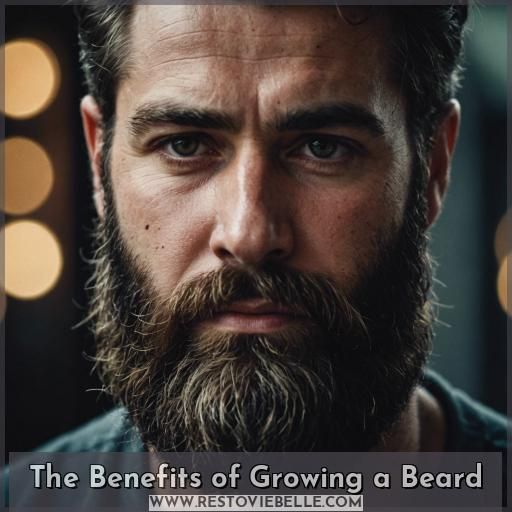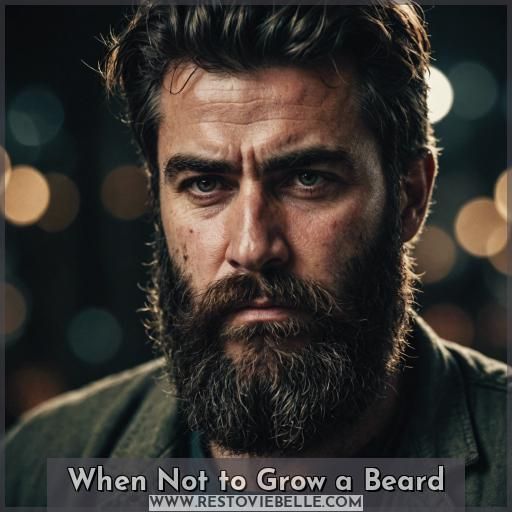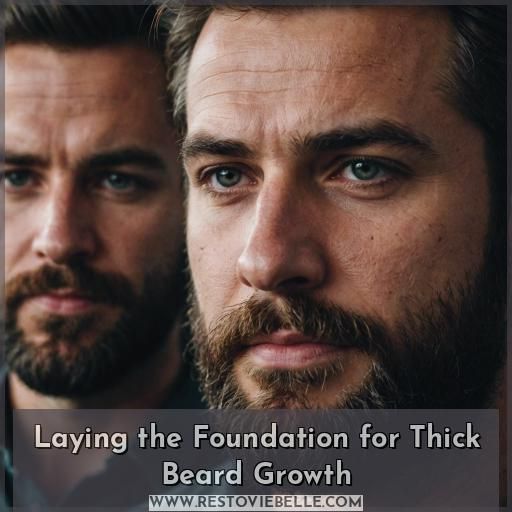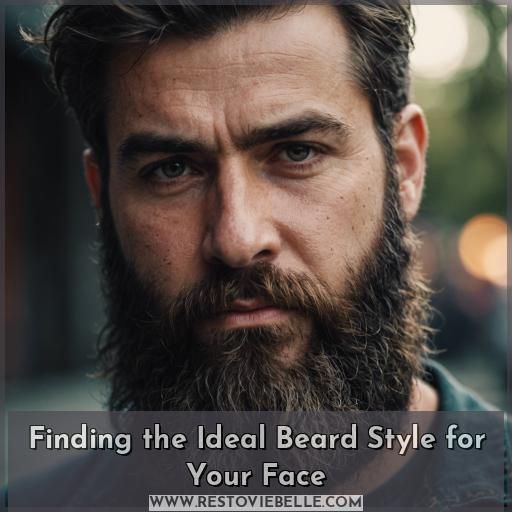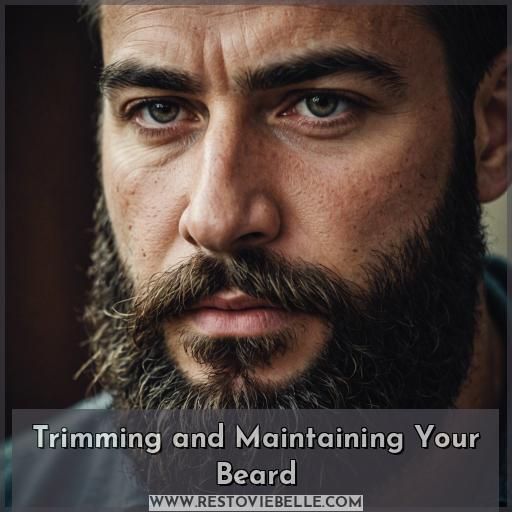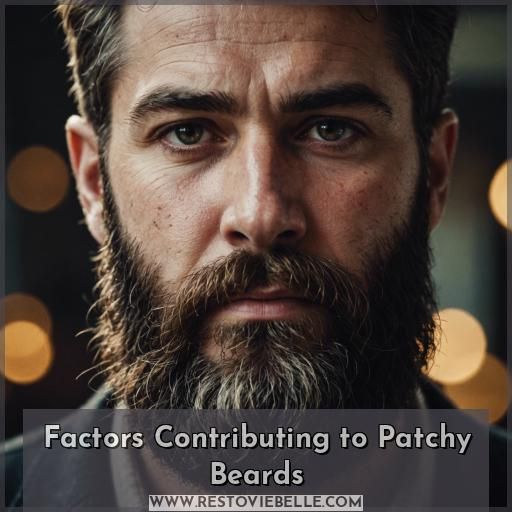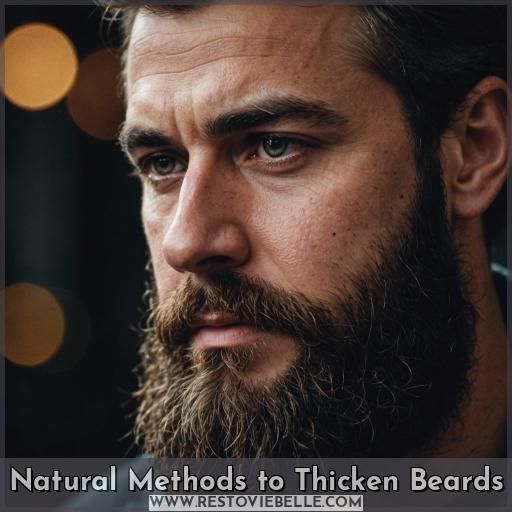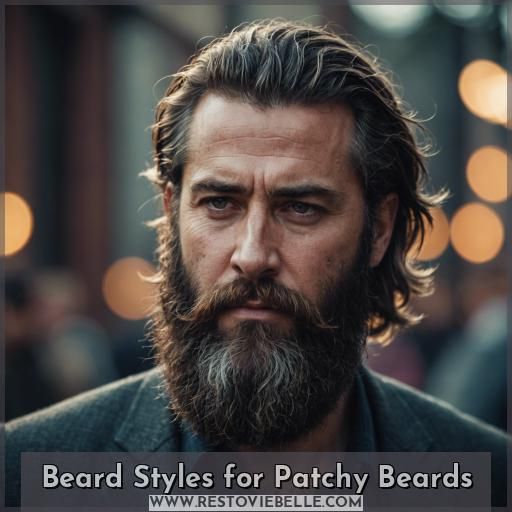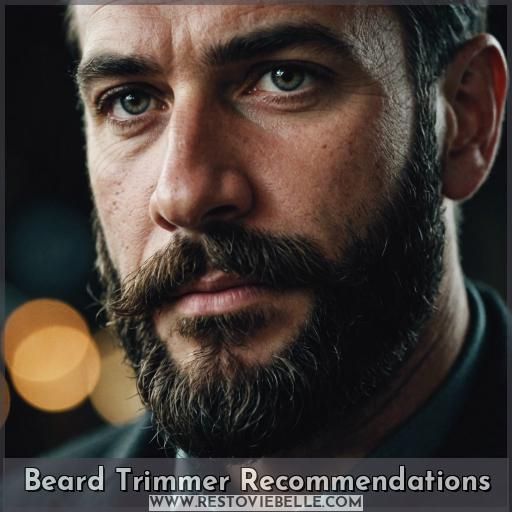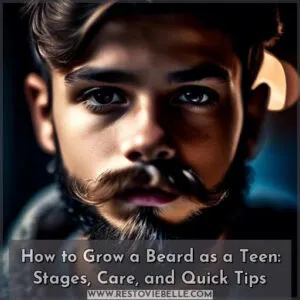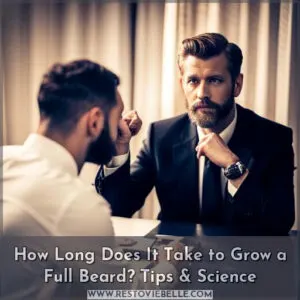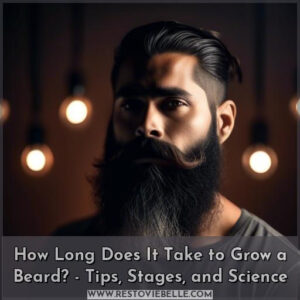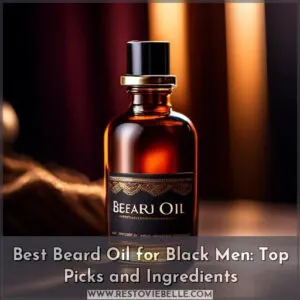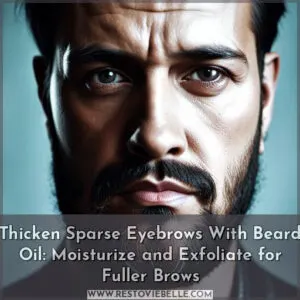This site is supported by our readers. We may earn a commission, at no cost to you, if you purchase through links.
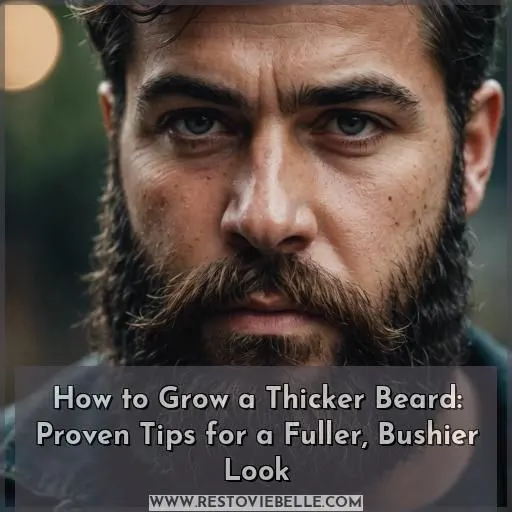 To grow a thicker beard, you’ll first need to commit to a 2-month growth period. Use a nourishing beard oil daily to keep your skin and facial hair healthy. Apply minoxidil to any patchy areas to stimulate follicles.
To grow a thicker beard, you’ll first need to commit to a 2-month growth period. Use a nourishing beard oil daily to keep your skin and facial hair healthy. Apply minoxidil to any patchy areas to stimulate follicles.
Maintain a proper neckline and keep your skin clean. Consider your face shape, natural growth pattern, and personal preferences to find the ideal beard style. Get regular professional trims to keep your beard looking its best.
Factors like genetics, hormones, nutrients, and stress can also impact beard thickness, so focus on a healthy lifestyle for fuller facial hair.
Table Of Contents
- Key Takeaways
- How to Grow a Thicker Beard?
- The Benefits of Growing a Beard
- When Not to Grow a Beard
- Laying the Foundation for Thick Beard Growth
- Finding the Ideal Beard Style for Your Face
- Trimming and Maintaining Your Beard
- Factors Contributing to Patchy Beards
- Natural Methods to Thicken Beards
- Vitamins and Nutrients for Faster Beard Growth
- Beard Styles for Patchy Beards
- Beard Trimmer Recommendations
- Frequently Asked Questions (FAQs)
- Conclusion
Key Takeaways
- Commit to a 2-month growth period, use nourishing beard oil daily, and apply minoxidil to patchy areas to stimulate follicles.
- Maintain a proper neckline, keep skin clean, and find the ideal beard style for your face shape and growth pattern.
- Factors like genetics, hormones, nutrients, and stress can impact beard thickness, so focus on a healthy lifestyle.
- Use natural methods like a nutrient-rich diet, regular exercise, exfoliation, and stress reduction to thicken facial hair.
How to Grow a Thicker Beard?
To grow a thicker beard, focus on maintaining proper facial hair health through regular trimming, conditioning, and nutrition. Avoiding common mistakes like over-grooming and using harsh products can also help encourage thicker beard growth.
The Benefits of Growing a Beard
Growing a beard can benefit your appearance in several ways. By cultivating a fuller, bushier look, you can enhance your masculine features, balance your face shape, and project a more mature, attractive image.
Increased Attractiveness
Grow a beard and watch heads turn. A well-groomed beard can enhance your attractiveness, highlighting your best facial features. Quality beard products nourish your facial hair, while proper beard shaping accentuates your unique bone structure. Whether you’re chasing that rugged look or aiming for a polished vibe, a thicker, healthier beard will have you feeling your most confident self.
Mature and Masculine Appearance
Growing a beard can bestow a more mature and masculine appearance, commanding instant respect and even a touch of beard envy from others. This rugged look is linked to increased testosterone and DHT levels, legacies of our genetic ancestors. Proper beard grooming with oils and trimmers will maintain this powerful aesthetic through changing trends and competitions.
Jawline Enhancement
A well-groomed beard can work wonders for your jawline. The right beard shape can create the illusion of a stronger, more defined jawline, complementing your natural features. Experiment with styles like the chin strap or Van Dyke to accentuate your bone structure. Use Minoxidil for patchy areas and keep your neckline trim to highlight your jawline.
Face Shape Balancing
Growing a beard can actually help balance out your facial features and proportions. The right beard shape can accentuate your angles and contours, creating a more symmetrical and harmonious look.
Experiment with different styles and use beard balm to maintain definition. A derma roller can also stimulate follicles for thicker growth.
Keep your beard well-groomed with a specialized beard wash for the best results.
Masculine Presence
A beard exudes an undeniable masculine presence. It commands attention, projects confidence, and signals a man’s mastery. Here’s how a beard can elevate your look:
- Beard Envy: A full, well-groomed beard is a mark of pride, attracting admiring glances.
- Beard Grooming: Maintaining a stylish beard shows you take pride in your appearance.
- Beard Trends: Sporting the latest beard styles keeps you looking on-point.
When Not to Grow a Beard
Not everyone should grow a beard. If you struggle to get through the initial grow-out period or have very sparse facial hair, a beard may not be the best look for you.
Inability to Endure Grow-Out Period
If you lack the patience to endure the initial grow-out phase, a beard may not be for you. Building endurance and shifting your mindset to embrace gradual progress is key. Focus on your sleep, diet, and exercise – these factors can impact growth, especially for patchy areas. With dedication, that scruffy look will fill in over time.
Sparse Facial Hair
If your facial hair grows in sparse and patchy, a full beard may not be the most flattering look for you. Genetics play a big role, and nutrient deficiencies or high stress can exacerbate the issue. However, using minoxidil and staying active can help stimulate growth. Be realistic about what your face can naturally support.
Laziness
Growing a beard can be tempting, but if you’re doing it just out of laziness, reconsider. Procrastination and lack of commitment won’t result in the beard you want. Instead, commit to the process – be disciplined about caring for your facial hair. With the right motivation and effort, you can achieve a full, healthy beard. Laziness won’t cut it.
Naturally Masculine Jawline
If you possess a naturally virile, photogenic jawline, consider refraining from cultivating a beard. A prominent, sculpted jawline is an enviable attribute that a beard may conceal. Nonetheless, a meticulously groomed and designed beard style could harmonize with your facial contours. Diligent beard upkeep with suitable products and trimming methods ensures your beard doesn’t diminish your rugged jawline.
Low Cheek Line
If you have a low cheek line, growing a beard may not be the best choice.
A low cheek line means your facial hair grows lower on your face, potentially creating an unflattering beard shape.
In this case, you’ll need to pay extra attention to trimming and maintenance to keep the beard looking neat and stylish.
Consider styles like a goatee or anchored beard that work well with a lower cheek line.
Laying the Foundation for Thick Beard Growth
To lay the foundation for a thick, full beard, you’ll need to commit to letting your facial hair grow for at least two months without trimming. During this essential growth phase, use a high-quality beard oil to keep the skin and hair follicles nourished and hydrated, as dry skin can inhibit growth.
2. Month Growth Period
If you can’t commit to the 2-month growth period, don’t bother trying – a patchy mess is worse than being clean-shaven. Patience is key here, so be prepared to:
- Endure the awkward in-between phase
- Resist the urge to trim too soon
- Ride out any doubts from others
Embrace the journey and your beard will thrive. It’s a marathon, not a sprint.
Beard Oil Moisturization
Alright, after letting your beard grow for 2 months, it’s time to moisturize. Beard oil is a game-changer – it additionally keeps your facial hair soft and manageable, but also nourishes the skin underneath. Check out this table for the benefits of different beard oil types:
| Oil Type | Benefits |
|---|---|
| Argan | Vitamin E, antioxidants |
| Jojoba | Mimics skin’s natural oils |
| Coconut | Antibacterial, antifungal |
| Castor | Promotes thickness, prevents breakage |
| Sweet Almond | Hydrates beard and skin |
Pick one that suits your needs and apply a few drops after showering for a fuller, bushier beard.
Minoxidil for Patchy Areas
If you’re struggling with patchy facial hair growth, consider using Minoxidil. Apply it directly to the sparse areas, following the usage instructions carefully. This topical treatment can stimulate follicles and promote thicker, fuller coverage. Just be mindful of any side effects and explore alternative options like dermarolling if Minoxidil doesn’t work for your unique growth pattern.
Maintaining Proper Neckline
Maintaining an appropriate neckline is essential for developing a thicker, more abundant beard. Keep your neckline trimmed below what you believe it should be – this produces the impression of a fuller beard. Utilize beard products such as oils and balms to soften the hairs and skin, enabling the beard to lay smoothly against your neck.
- Trim your neckline lower than you perceive
- Utilize beard oils and balms to soften hairs
- A lower neckline generates a fuller, more abundant appearance
Keeping Skin Clean
Maintaining your skin’s health is essential for a flourishing beard. Adopt a basic skincare regimen – cleanse, exfoliate, and hydrate regularly. This prepares your skin for ideal hair growth by clearing pores, eliminating dead skin cells, and delivering necessary moisture. Cherish your skin, and your beard will thrive.
Finding the Ideal Beard Style for Your Face
When selecting the ideal beard style for your face, attentively assess your face shape, natural hair growth pattern, and personal preferences. Articulate these details lucidly with your barber to guarantee they can assist you in attaining the perfect beard style that complements your features and necessitates the appropriate level of upkeep.
Face Shape Consideration
Now that you’ve laid the groundwork for thick beard growth, it’s time to give thought to your face shape. Your beard shape should enhance your natural features and bring out the best in your appearance. Think about your face symmetry, growth pattern, and personal style preferences. Share photos with your barber to guarantee the perfect fit.
- Highlight your most prominent facial features
- Balance proportions for a harmonious look
- Express your unique style through beard shape
- Collaborate with your barber for expert guidance
Natural Growth Pattern
When choosing your ideal beard style, consider your natural beard growth pattern. Some guys have wispy, fine hairs that work better with shorter styles, while others have thick, coarse hair suited for longer beards. Examine how your facial hair grows to determine the look that will accentuate your face proportions and personal style.
| Beard Shape | Hair Type | Lifestyle |
|---|---|---|
| Rounded | Fine | Formal |
| Angular | Coarse | Casual |
| Tapered | Thick | Active |
Personal Preferences
Once you’ve considered your face shape and natural growth pattern, it’s time to think about your personal preferences when finding the ideal beard style. Do you want a rugged, full-bodied beard or a more neatly trimmed, sculpted look? Beard grooming and styling products can help you achieve your desired beard aesthetic and keep it well-maintained.
Communicating With Barber
When you’ve settled on the ideal beard style for your face, be sure to bring photos to your barber. This will help them understand the exact shape and length you’re going for, allowing them to expertly trim and sculpt your beard to perfectly complement your features. With clear visuals, they can create the perfect beard for your face.
Maintenance Requirements
Maintaining your ideal beard style requires a consistent care routine. Stick to a regular trimming schedule to keep your look sharp. Carefully select grooming products to nourish and shape your facial hair. And don’t forget to consult with your barber on the best way to style and trim your unique beard.
Trimming and Maintaining Your Beard
To keep your beard looking its best, start with a professional trim. Then, maintain it by regularly trimming your beard when it’s dry to remove any stray hairs and keep your desired shape.
Professional Trim
First, get a professional trim to shape and define your beard’s ideal length and neck line. Your barber’s skilled hands can expertly sculpt your facial hair to flatter your unique face shape and neck. Regular trims prevent scraggly edges and maintain a clean, polished look, while also avoiding skin irritation from overgrowth. Trust the pros for your perfect neckline.
Dry Trimming
Now that you’ve gotten a professional trim, it’s time for the dry trim.
This is where you take your beard trimmer and carefully shape your beard while it’s dry.
This allows you to see the exact lines and contours, and avoid any uneven patches.
Just be sure to use a high-quality beard oil to keep your facial hair healthy and conditioned.
Stray Hair Removal
Once your beard is dry, take a small pair of scissors and carefully trim any stray hairs poking out from its defined shape. This step guarantees a clean, well-groomed look – essential for proper beard maintenance. Apply a few drops of beard oil afterward to stimulate hair follicles and prevent dry, flaky skin.
Trimmer or Scissors
Once you’ve removed stray hairs, you’ll need to decide between using a beard trimmer or scissors. Trimmers like the BT7440 provide precision lengths, while scissors offer more control. Shaping with trimmers reduces risk of razor burn or beard irritation. If using a razor, go with a beard shaper or safety razor to prevent irritation.
Dedicated Trim Time
After using your trimmer or scissors, reserve some regular time for trimming.
Consistency is key – aim for a weekly trim to maintain your desired shape.
Don’t rush it – take your time to get it right.
Invest in a good beard brush; it’ll evenly distribute oils while training hairs to grow in the right direction, enhancing your face shape.
Factors Contributing to Patchy Beards
Patchy, thin beards can often be traced back to underlying factors like genetics, hormonal imbalances, nutrient deficiencies, high stress levels, or a lack of exercise. Addressing these potential contributors through lifestyle adjustments, proper nutrition, and beard care routines can help promote fuller, thicker beard growth over time.
Genetics
After perfecting your trim routine, you may still struggle with patchy growth due to genetics. Hair growth is influenced by:
- Hair follicle sensitivity
- Testosterone levels
- Family beard patterns
- Hair thinning genes
While you can’t change your DNA, understanding its role allows you to manage expectations and explore other solutions like minoxidil or tactical styling. Embrace your unique beard journey!
Hormonal Imbalances
Can’t grow that full beard you desire? Hormonal changes might be the culprit. Testosterone and DHT play a crucial role in facial hair growth. But high cortisol from stress can lower their levels, leading to patchy areas. Stay on top of your thyroid function too – any imbalances there can throw a spanner in the works.
Nutrient Deficiencies
Along with hormones, your nutrient intake impacts beard growth. Deficiencies in vitamins like A, B, C, E, and minerals like zinc and iron can hinder hair follicle health. Eat a balanced diet rich in protein, fruits, veggies, and healthy fats to fuel your beard’s journey. If needed, consider dietary supplementation to plug any nutritional gaps.
Stress
High stress crushes your testosterone levels, sabotaging beard growth. Stress from work, relationships, or lifestyle takes a toll – you’ll notice patchy, thin facial hair. Combat stress through relaxation techniques like meditation or yoga. Consider adaptogenic supplements to balance your body’s stress response for ideal beard gains.
Lack of Exercise
In addition to stress, lack of exercise also contributes to patchy beards. Exercise boosts testosterone levels, which promote hair growth. It also improves blood circulation, ensuring proper nutrient delivery to hair follicles. You’ll notice your beard growing in thicker and fuller when you incorporate regular physical activity into your routine.
Natural Methods to Thicken Beards
To naturally thicken your beard, prioritize a balanced diet rich in nutrients like vitamins A, B, C, E, and biotin—these provide essential nourishment for healthy hair follicles. Complementing your diet with regular exercise promotes increased blood flow and testosterone production, further stimulating beard growth.
Healthy Diet
A healthy diet is essential for beard growth. Choose nutrient-packed foods like fatty fish, fruits, vegetables, and lean proteins to provide nourishment to hair follicles. Plan your mealsを中心として around nutritious ingredients that supply vital vitamins, minerals, and antioxidants. Making wise food choices and adhering to a well-balanced diet can lay the groundwork for a fuller, thicker beard.
Regular Exercise
Along with a healthy diet, regular exercise boosts beard growth. It increases blood flow, delivering more nutrients to hair follicles. Try:
- Cardio exercises to improve circulation
- Weightlifting to raise testosterone levels
- Yoga for stress relief and better sleep
- Stretching routines to reduce beard dandruff
- HIIT workouts for an overall fitness boost
Exercise stimulates follicles, reduces hair loss, and keeps skin irritation at bay for a thicker, fuller beard.
Exfoliation
Exfoliation is essential. It removes dead skin cells, enabling new hair to grow effortlessly. Endeavor to exfoliate 2-3 times weekly with a mild scrub or brush. Sensitive skin? Utilize soft washcloths. Premium exfoliation products embrace natural elements like jojoba beads or salt crystals. The advantages? Accelerated growth, diminished ingrowns, and an overall thicker, healthier beard.
Adequate Rest
You’ve exfoliated to remove dead skin cells, now it’s time to get sufficient rest. Lack of sleep inhibits beard growth by disrupting testosterone production and melatonin release. Aim for:
- 7-9 hours of quality sleep per night
- Consistent sleep schedule
- Dark, cool bedroom environment
- Relaxing pre-bed routine
Restful nights allow your body to function effectively, promoting fuller beard growth.
Stress Reduction
Alongside obtaining sufficient rest, mitigating stress is essential for robust beard development. Persistent stress escalates cortisol levels, disrupting hormones such as testosterone and hindering the function of hair follicles. Engage in stress-alleviating activities like physical exercise, meditation, or deep breathing exercises to assist in reducing cortisol and establishing conditions favorable for fuller beard growth.
Vitamins and Nutrients for Faster Beard Growth
To promote thick, healthy beard growth, focus on consuming a diet rich in vitamins A, B, C, E, and beta-carotene. These essential nutrients support hair follicle development, collagen production, and overall skin and hair health – crucial factors for achieving a fuller, more robust beard.
Vitamin A
You need Vitamin A for luscious locks! Deficiency can slow hair growth, so get enough of this nutrient:
- Eat plenty of orange veggies like carrots and sweet potatoes
- Go for leafy greens like spinach and kale
- Add dairy, eggs, and fatty fish to your diet
Vitamin A aids nutrient absorption and collagen production – key for strong beard hairs.
Vitamin B
Vitamin B is essential for healthy beard growth. It supports hair follicle development and prevents nutrient deficiencies that can hinder growth. B vitamins promote collagen production, contributing to healthy skin and strong hair roots. Integrate whole grains, legumes, eggs, and leafy greens into your diet to secure adequate B vitamin intake for maximum beard thickness.
Vitamin C
Vitamin C, the antioxidant powerhouse, is essential for your beard growth. It supports collagen production, which strengthens hair follicles and promotes healthy hair. Plus, vitamin C enhances blood circulation, delivering essential nutrients to your facial hair. Incorporate citrus fruits, bell peppers, and leafy greens into your diet for a lush, fuller beard.
Vitamin E
Vitamin E is a powerful antioxidant that nourishes your beard from the inside out. It helps protect your hair follicles and scalp from damage, promoting healthy growth and preventing premature greying. Incorporate vitamin E-rich foods like almonds, avocados, and spinach into your diet, or consider a supplement to give your beard an extra boost.
Beta-carotene
Along with vitamins A, B, C, and E, you’ll want to make certain you’re getting enough beta-carotene – a powerful antioxidant that converts to vitamin A in your body. Beta-carotene promotes healthy skin and hair growth, so load up on orange veggies like carrots, sweet potatoes, and squash for a thicker, fuller beard.
Beard Styles for Patchy Beards
If you’re dealing with patchy beard growth, certain styles can help camouflage and compensate for sparse areas. The chin strap, goatee, 5 o’clock shadow, Van Dyke, and anchor beard are all excellent options for embracing a stylish yet manageable look when your facial hair is uneven or thin in some zones.
Chin Strap
If you’re struggling with patchiness, the chin strap beard is a sharp, defined style that emphasizes your jawline for a professional look. Keep it trimmed close, outlining your jaw and chin area – it creates the illusion of fuller growth while working with sparse facial hair.
Goatee
The goatee is a versatile look for those with patchy facial hair. It balances a strong chin with minimal maintenance. Keep it trimmed for a polished appearance using goatee-specific trimmers and moisturizing products. Experiment with different goatee styles – from a classic thin strip to a wider sculpted shape. With proper grooming, you’ll rock a sleek yet masculine vibe.
5 O’clock Shadow
If you’ve got a patchy beard but still want a rugged, masculine look, the 5 o’clock shadow might be your solution. With minimal growth needed, this low-maintenance style gives the effortless appearance of weekend stubble. Plus, the shadowy coverage can help camouflage any sparse areas in your beard growth while looking undeniably sexy.
Van Dyke
If your patchiness lies on the cheeks, the Van Dyke—a pointed beard with mustache—could suit you.
This classic style traces its roots to the 17th century, gaining popularity among gentlemen and artists.
Maintaining it requires regular trimming and shaping—a worthwhile effort for those seeking a distinguished, artistic look.
Celebrities like Johnny Depp have rocked variations of the Van Dyke, demonstrating its timeless appeal.
Anchor
The anchor beard, featuring a small patch of hair on the chin, is a stylish choice for those with patchy facial hair growth. Its simple yet refined look can help balance out an uneven beard and create the appearance of a stronger jawline. Pair it with a neat neck trim for a polished, masculine finish.
- Draws attention to your chin and jawline
- Low maintenance compared to fuller beard styles
- Flatters various face shapes, especially rounder ones
Beard Trimmer Recommendations
Concerning beard trimming, consider purchasing a premium-quality trimmer tailored to your unique requirements. The Gillette BT7440 and BT3440 Beard Trimmers provide precise control and accessories to assist you in achieving your desired beard aesthetic. Alternatively, all-in-one trimmers and shavers can deliver a closer and more consistent trim across your facial growth.
BT7440 Beard Trimmer
Elevate your beard grooming with the BT7440 Beard Trimmer. This precision tool features a dial that lets you effortlessly adjust the length, plus 4 attachments for versatile styling. And thanks to the integrated Gillette razor, you’ll get a close, clean trim every time. Simplify your growth period with this all-in-one powerhouse.
BT3440 Beard Trimmer
The BT3440 beard trimmer offers a versatile solution for maintaining your facial hair. With 2 comb attachments, you can achieve a variety of lengths to suit your style.
The trimmer’s cordless design and long battery life allow for convenient, on-the-go grooming. Plus, its wet/dry capability makes it easy to use in the shower for a hassle-free trim.
The BT3440 comes backed by a 2-year warranty, so you can trim with confidence.
All-in-One Trimmers
All-in-One Trimmers offer versatile styling options for your grooming needs. These multi-purpose tools provide a compact design, making them travel-friendly. With a range of attachments, you can tackle your entire facial hair regimen, from trimming your beard to outlining your edges. Invest in an All-in-One Trimmer for a convenient, all-encompassing grooming experience.
| Feature | BT7440 | BT3440 | All-in-One |
|---|---|---|---|
| Precision | |||
| Attachments | 4 | 2 | Multiple |
| Portability |
Shavers
For a close, gentle shave, opt for a quality electric razor or manual razor. When shaving sensitive skin, use a warm shave cream and shave in the direction of hair growth. Replace razor blades frequently to guarantee a clean, comfortable shave. Electric razors can be convenient for daily dry shaving, while wet shaving provides a closer finish.
Beard Trimmers
With regards to beard trimmers, there are several exceptional choices to contemplate. The BT7440 and BT3440 models provide precise control, numerous attachments, and the practicality of a Gillette razor.
Versatile trimmers cater to head-to-toe grooming, while conventional beard trimmers grant up to 39 length adjustments for customized grooming.
Combine your trimmer with superior beard oils to nourish and preserve your facial hair for a fuller, healthier beard.
Frequently Asked Questions (FAQs)
How do I make my beard thicker and fuller?
To sprout a luscious beard, let your hair down and free its full potential! Nourish those follicles with a healthy diet, exercise, and targeted products. Consistency is key – chin up, and let that mane thrive!
What are some effective beard-growing tips?
Grow a thicker beard by letting it thrive – nourish it with nutrient-rich foods, hydrate your skin, and use specialized products that’ll stimulate follicles. With patience and consistency, you’ll cultivate the full, healthy beard you desire.
How can I prevent patchiness in my beard?
Tackle patchy beard growth by nourishing your skin. Eat right, exercise, and manage stress. Use beard oils and serums to stimulate follicles. Be patient – consistent care is key to achieving that full, lush beard.
What are the best products for beard growth?
Unveil the secret to luscious locks – beard oils, creams, and vitamins perform their wonders, nourishing your facial hair from root to tip. Embrace the potency of proper beard care and behold the flourishing of your mane.
What lifestyle changes can promote thicker beard growth?
You can’t rush beard growth, but lifestyle tweaks like managing stress, eating well, and exercising regularly can boost testosterone and nourish follicles for a fuller, smoother beard. Consistency is key – stick with it, and you’ll get there!
Conclusion
Yearning for a fuller, more striking beard? With patience, proper grooming, and a healthy lifestyle, you can grow a thicker, denser beard that complements your face perfectly.
By following the proven tips outlined in this guide, you’ll be on your way to mastering the art of how to grow a thicker beard. Embrace the transformative power of facial hair and let your beard become a confident expression of your personal style.
- beardresource.com
- beardoholic.com
- beardbrand.com

